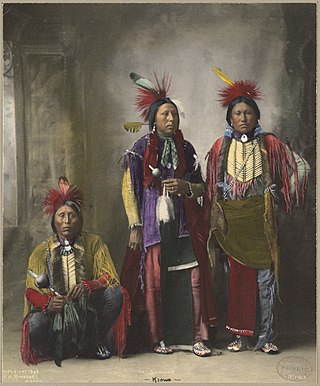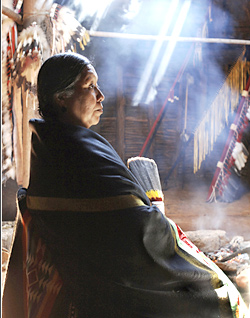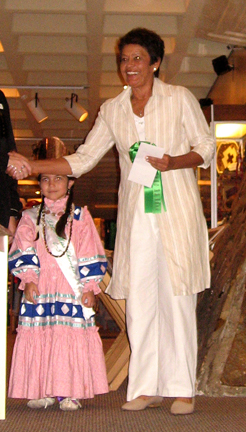Related Research Articles

Kiowa or CáuigúIPA:[kɔ́j-gʷú]) people are a Native American tribe and an Indigenous people of the Great Plains of the United States. They migrated southward from western Montana into the Rocky Mountains in Colorado in the 17th and 18th centuries, and eventually into the Southern Plains by the early 19th century. In 1867, the Kiowa were moved to a reservation in southwestern Oklahoma.

The Institute of American Indian Arts (IAIA) is a public tribal land-grant college in Santa Fe, New Mexico, United States. The college focuses on Native American art. It operates the Museum of Contemporary Native Arts (MoCNA), which is housed in the historic Santa Fe Federal Building, a landmark Pueblo Revival building listed on the National Register of Historic Places as Federal Building. The museum houses the National Collection of Contemporary Indian Art, with more than 7,000 items.
Harjo is a surname, derived from the Muscogee word Hadcho meaning "Crazy" or "So Brave as to Seem crazy".
Teri Greeves is a Native American beadwork artist, living in Santa Fe, New Mexico. She is enrolled in the Kiowa Indian Tribe of Oklahoma.
Lois Smoky Kaulaity (1907–1981) was a Kiowa beadwork artist and a painter, one of the Kiowa Six, from Oklahoma.

Vanessa Paukeigope Santos Jennings is a Kiowa/Kiowa Apache/Gila River Pima regalia maker, clothing designer, cradleboard maker, and beadwork artist from Oklahoma.

Richard Aitson was a Kiowa-Kiowa Apache bead artist, curator, and poet from Oklahoma.

Virginia Alice Stroud is a Cherokee-Muscogee Creek painter from Oklahoma. She is an enrolled member of the United Keetoowah Band of Cherokee Indians.

Marcelle Sharron Ahtone Harjo is a Kiowa painter from Oklahoma. Her Kiowa name, Sain-Tah-Oodie, translates to "Killed With a Blunted Arrow." In the 1960s and 1970s, she and sister Virginia Stroud were instrumental in the revival of ledger art, a Plains Indian narrative pictorial style on paper or muslin.
Jolene Rickard, born 1956, citizen of the Tuscarora Nation, Turtle clan, is an artist, curator and visual historian at Cornell University, specializing in indigenous peoples issues. Rickard co-curated two of the four permanent exhibitions for the Smithsonian’s National Museum of the American Indian.

Southern Plains Indian Museum is a Native American museum located in Anadarko, Oklahoma. It was opened in 1948 under a cooperative governing effort by the United States Department of the Interior and the Oklahoma state government. The museum features cultural and artistic works from Oklahoma tribal peoples of the Southern Plains region, including the Caddo, Chiricahua Apache, Comanche, Delaware Nation, Kiowa, Plains Apache, Southern Arapaho, Southern Cheyenne, and Wichita.
Mary Adair is a Cherokee Nation educator and painter based in Oklahoma.
heather ahtone, PhD (Chickasaw), is director of Curatorial Affairs at the First Americans Museum.
Ahtone is a Kiowa surname. Notable people with the surname include:
The Center of the American Indian (CAI) was an intertribal, Native American-led museum in Oklahoma City, Oklahoma. It was housed in the second floor of the Kirkpatrick Center.
References
- Pearce, Richard (2013). Women and Ledger Art: Four Contemporary Native American Artists. Tucson: University of Arizona Press. ISBN 978-081652104-3.
- Hail, Barbara (2000). Gifts of Pride and Love: Kiowa and Comanche Cradles. Bristol, RI: Brown University. ISBN 978-0806136042.